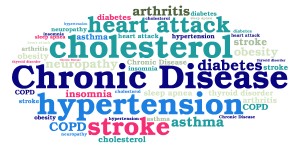Daily activity levels need to be several times higher than recommended minimum
Higher levels of total physical activity are strongly associated with lower risk of five common chronic diseases – breast and bowel cancer, diabetes, heart disease and stroke, finds a study in The BMJ today.
Many studies have shown the health benefits of physical activity. This has led the World Health Organization (WHO) to recommend a minimum total physical activity level of 600 metabolic equivalent (MET) minutes a week across different ‘domains’ of daily life.
This can include being more physically active at work, engaging more in domestic activities such as housework and gardening, and/or engaging in active transportation such as walking and cycling.
But we still do not definitively know how much the type and quantity of physical activity reduces the risk of common conditions.
|
So a team of researchers based in the US and Australia analysed the results of 174 studies published between 1980 and 2016 examining the associations between total physical activity and at least one of five chronic diseases – breast cancer, bowel (colon) cancer, diabetes, ischemic heart disease, and ischemic stroke. They found that a higher level of total weekly physical activity was associated with a lower risk of all five conditions. |
|
Most health gains occurred at a total activity level of 3000-4000 MET minutes a week, with diminishing returns at higher activity levels. A person can achieve 3000 MET minutes a week by incorporating different types of physical activity into their daily routine – for example, climbing stairs for 10 minutes, vacuuming for 15 minutes, gardening for 20 minutes, running for 20 minutes, and walking or cycling for 25 minutes. The results suggest that total physical activity needs to be several times higher than the current recommended minimum level of 600 MET minutes a week to potentially achieve larger reductions in risks of these diseases, say the authors. Although they cannot tell us about cause and effect, meta- analyses involving observational research are useful for pulling evidence together. And the authors say their findings have several important implications. |
|
“With population ageing, and an increasing number of cardiovascular and diabetes deaths since 1990, greater attention and investments in interventions to promote physical activity in the general public is required,” they write. |
|
“More studies using the detailed quantification of total physical activity will help to find a more precise estimate for different levels of physical activity,” they conclude. In a linked editorial, researchers at the University of Strathclyde and the International Prevention Research Institute in Lyon, France say this study “represents an advance in the handling of disparate data on a lifestyle factor that has considerable importance for the prevention of chronic diseases.” But they point out that “it cannot tell us whether risk reductions |
|
would be different with short duration intense physical activity or longer duration light physical activity.” They conclude: “Future studies must streamline their measurement and reporting for real gains in knowledge.” [Ends] Note to Editors: Research: Physical activity and risk of breast cancer, colon cancer, diabetes, ischemic heart disease, and ischemic stroke events: systematic review and dose-response meta-analysis for the Global Burden of Disease Study 2013 http://www.bmj.com/content/354/bmj.i3857 Editorial: Meaningless METS: studying the link between physical activity and health About BMJ |
|
BMJ is a healthcare knowledge provider that aims to advance healthcare worldwide by sharing knowledge and expertise to improve experiences, outcomes and value. For a full list of BMJ products and services, please visit bmj.com. |
